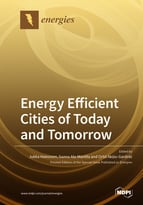Energy Efficient Cities of Today and Tomorrow
A special issue of Energies (ISSN 1996-1073). This special issue belongs to the section "G: Energy and Buildings".
Deadline for manuscript submissions: closed (29 June 2020) | Viewed by 35165
Special Issue Editors
Interests: sustainable built environment; life cycle assessments; carbon footprinting; greenhouse gas mitigation; sustainable urban development; built environment; life cycle economics
Special Issues, Collections and Topics in MDPI journals
Interests: sustainable cities; urbanization; climate change mitigation; well-being; socioeconomic segregation
Special Issues, Collections and Topics in MDPI journals
Interests: energy footprint; energy transitions; input–output analysis; sustainability; well-being; life cycle assessment
Special Issues, Collections and Topics in MDPI journals
Special Issue Information
Dear Colleagues,
The world needs to change. With rapid ongoing urbanization and ever-growing harmful environmental impacts from urban areas, the focus of this required sustainability transformation is on cities. However, cities are known to create wealth and economic growth. Cities are also providing their citizens with evermore diverse consumption opportunities, making the lifestyles of city dwellers more and more consumption-oriented. This inevitably leads to increased energy demands and emissions in cities due to needed infrastructure and real estate development, the increased energy demands of users, and the increased energy embodied in the goods and services consumed within cities. Concurrently, we are facing imminent pressure to significantly reduce our energy consumption and greenhouse gas emissions at all levels of society. This pressure behoves cities to re-establish themselves as low-energy/low-carbon urban ecosystems.
There has been an ongoing, lively academic discourse on the Issue for several years, so far without widely accepted or unanimous solutions. This Special Issue “Energy Efficient Cities of Today and Tomorrow” seeks to enhance this conversation and provide a more profound understanding of the future energy requirements of urban areas and low-energy and low-carbon cities.
We welcome both conceptual and empirical study papers. Papers involving energy or greenhouse gas simulation and modeling are likewise welcomed. The following list of topics is in no way exhaustive, but is intended to inspire the authors’ writing. All topics relevant to the theme of ‘’Energy Efficient Cities of Today and Tomorrow’’ are equally welcomed. Potential topics include the following:
- Low-energy/low-carbon city concepts;
- Energy solutions for low-carbon urban areas;
- Low-energy/low-carbon urban ecosystems;
- Energy-efficient urban transitions;
- Sustainable urban living;
- Drivers and barriers for low-energy/low-carbon solutions;
- Energy system changes in urban communities.
Papers presenting research results with sound academic contributions and high societal impact potential are particularly welcomed.
Prof. Dr. Jukka Heinonen
Assistant Prof. Dr. Sanna Ala-Mantila
Dr. Ortzi Akizu-Gardoki
Guest Editors
Manuscript Submission Information
Manuscripts should be submitted online at www.mdpi.com by registering and logging in to this website. Once you are registered, click here to go to the submission form. Manuscripts can be submitted until the deadline. All submissions that pass pre-check are peer-reviewed. Accepted papers will be published continuously in the journal (as soon as accepted) and will be listed together on the special issue website. Research articles, review articles as well as short communications are invited. For planned papers, a title and short abstract (about 100 words) can be sent to the Editorial Office for announcement on this website.
Submitted manuscripts should not have been published previously, nor be under consideration for publication elsewhere (except conference proceedings papers). All manuscripts are thoroughly refereed through a single-blind peer-review process. A guide for authors and other relevant information for submission of manuscripts is available on the Instructions for Authors page. Energies is an international peer-reviewed open access semimonthly journal published by MDPI.
Please visit the Instructions for Authors page before submitting a manuscript. The Article Processing Charge (APC) for publication in this open access journal is 2600 CHF (Swiss Francs). Submitted papers should be well formatted and use good English. Authors may use MDPI's English editing service prior to publication or during author revisions.
Keywords
- Low-energy/low-carbon city concepts
- Energy solutions for low-carbon urban areas
- Low-energy/low-carbon urban ecosystems
- Energy-efficient urban transitions
- Sustainable urban living
- Drivers and barriers for low-energy/low-carbon solutions
- Energy system changes in urban communities.








